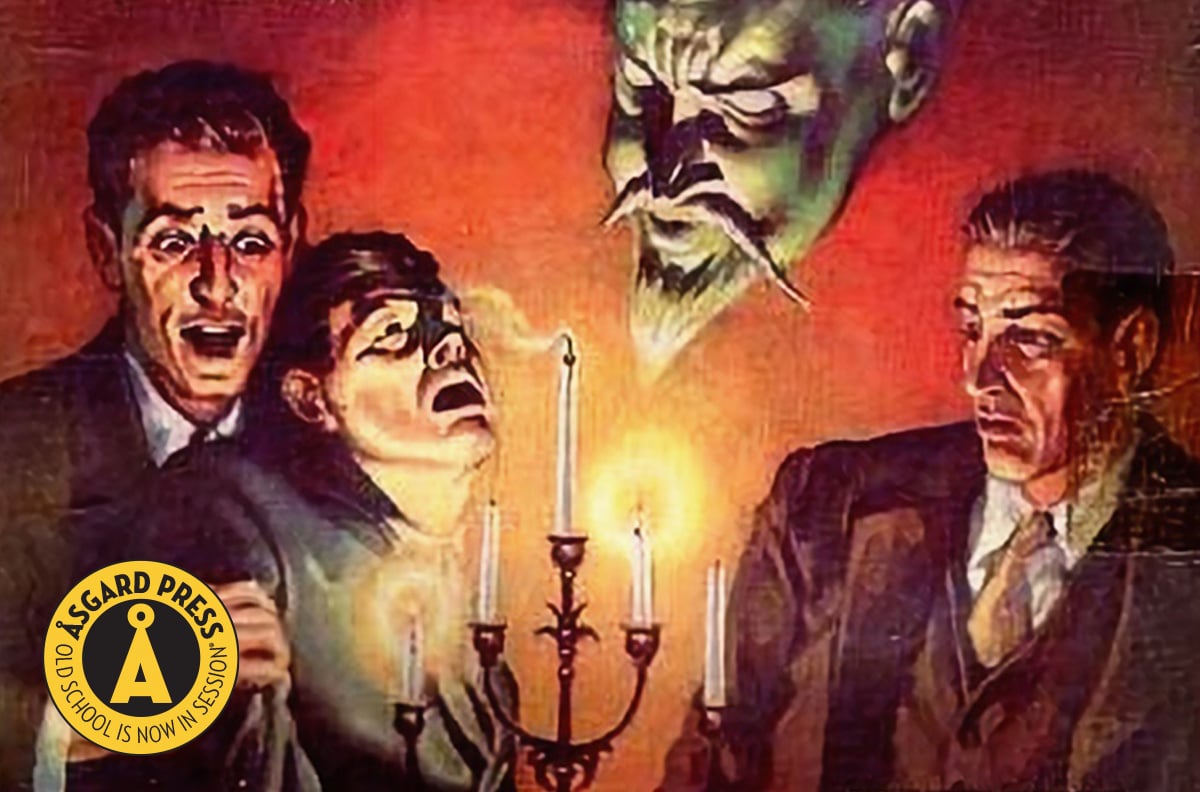The Golden Age of Pulp Horror Magazines
The fascination many people have with tales of horror is as old as time. The intention of horror is to evoke fear, disgust, or shock and is often accompanied by messages about society written into the tales using metaphor. This frightfully fun genre of storytelling goes all the way back to our days of telling the tales orally, rooted in folklore and religious tradition. Written tales of horror can be found in the ancient works of playwrights and authors such as Euripides and Plutarch, and even in the Book of Revelation in the Bible.
Early Horror Fiction
In the Middle Ages, fear-filled stories featuring werewolves, ghosts, and witches were common and popular. Many of characters in these narratives were based on actual people of this brutal era, some of which committed heinous acts of war and violence. Medieval tales inspired many future authors, and the horror genre of writing finally began to hit its stride in the 18th century, which saw the rise of Gothic horror. The classic novel The Castle of Otranto, written in 1764 by Horace Walpole, was controversial in its time due to its groundbreaking combination of fantasy with realist fiction. This book was the first English supernatural novel and laid the blueprint for all horror fiction to come, including Bram Stoker’s Dracula and Mary Shelley’s Frankenstein.
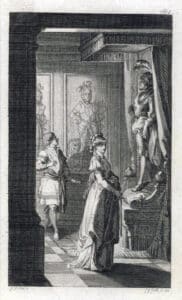
The Beginnings of Pulp Fiction & Pulp Horror
In the late 19th and early 20th centuries, steam-powered printing presses gave rise to a proliferation of inexpensive literary entertainment. In 1896, magazine publisher Frank Munsey launched the pulp magazine era by combining cheap printing, wood pulp paper, and low-paid authors and illustrators into one affordable package with Argosy Magazine, 192 untrimmed pages of affordable, yet sensational, action and adventure. Subsequent publishers piggybacked on Munsey’s success and the Golden Age of pulp magazines hit its peak in the 1920s – 1940s.
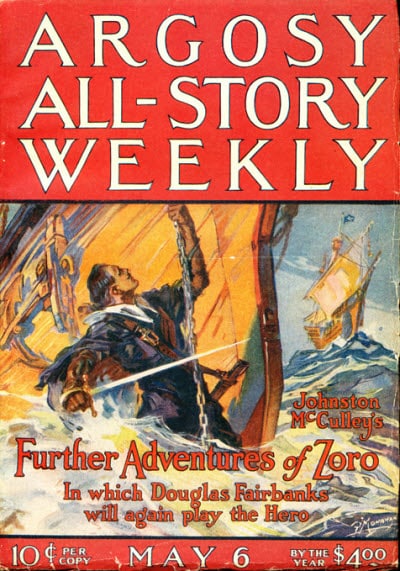
The horror genre of pulp fiction, under the umbrella of speculative fiction and a descendant of the British penny dreadful, spawned publications such as Ghost Stories, Thrilling Mystery, Terror Tales, Weird Tales, and Horror Stories. Many famous and soon-to-be famous authors contributed to these magazines, including H.G. Wells, M.R. James, Tod Robbins, and the prolific H.P. Lovecraft. Lovecraft’s iconic The Call of Cthulhu debuted in Weird Tales in 1928. Many of the themes and much of the imaginative imagery of these stories were crossovers with the science fiction genre; their commonality was fear of the unknown. Sub-genres and related genres of pulp horror include weird fiction, occult fiction, ghost stories, crime fiction, and monster fiction.
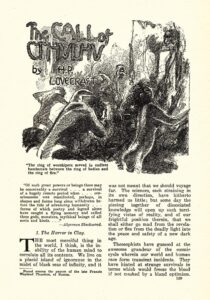
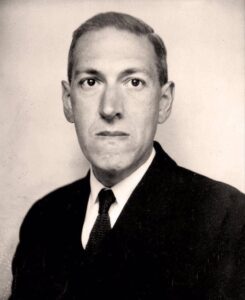
What all the pulp horror publications had in common was the ability to evoke fear and suspense in the reader. Ghost Stories (MacFadden Publications, 1926-1931) presented tales with a “confessional” approach, in which the author enhances the terror with attempts to make the readers believe the story they are reading is true, which the magazine sometimes tried to substantiate by including doctored photos. The very first Agatha Christie story to be published in North America, “The Woman Who Stole a Ghost,” appeared in Ghost Stories in 1926.
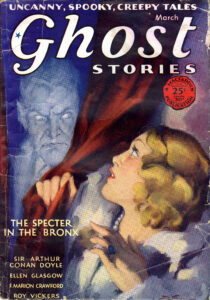
Other pulp horror publications took on the sub-genre of weird menace, also known as shudder pulps. Shudder pulps emerged around 1933 and were popular until around 1941, when reformers shut them down due to their gratuitous depictions of violence. In weird menace fiction, the hero characters, often including scantily clad damsels in distress, are pursued, threatened, or attacked by the likes of mad scientists, evil surgeons, deranged serial killers, even crazed cult leaders. These tales were so lurid, with cover art so provocative, that the magazines were often kept under the counter in shops. One such publication was Dime Mystery, launched by Popular Publications in 1933, which was reinvented as a traditional mystery magazine after public outcry ran the shudder pulps out of town.
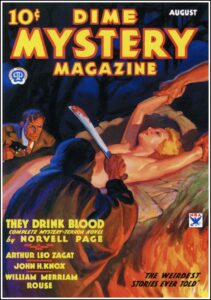
Pulp Fantasy
One of the many approaches the pulps took to horror was that of the fantasy genre. Magazines such as Unknown (Street & Smith, 1939-1943) published a variety of fantasy fiction with plotlines involving werewolves, time travel, and magic. Unknown had a reputation for high quality horror and fantasy writing, with authors such as L. Ron Hubbard and L. Sprague de Camp, who both later became known for their science fiction work. Editor John W. Campbell insisted that all fantasy stories for Unknown be rooted in reality and have rational, even if completely fictional, explanations. This, he felt, would lend an air of quality to the pulp fantasy genre, which he believed to be previously tarnished by the shudder pulps.
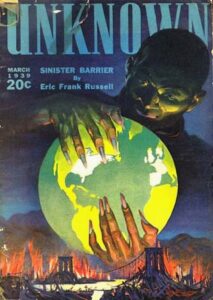
The Decline of the Pulps
By the advent of World War II, the pulp magazine industry was severely hampered by paper shortages, high prices, and a dwindling interest in sensationalized literature as real horror played out across the globe. Many of the pulp publishers folded during this time period, while others stayed afloat by restructuring themselves as hero or adventure magazines, abandoning the pulp format for a more traditional magazine look. Eventually the decline of the pulps gave rise to a new, and even more enduring genre of short fiction: the comic book.
The pulp fiction lines between horror, fantasy, science fiction, and mystery were somewhat blurred, so many readers found themselves subscribed to multiple publications. Pulp horror stories often had elements of aliens, crime, time travel, and the occult. Authors such as H.P. Lovecraft fully embraced those blurred lines to produce lasting works that continue to influence writers, musicians, and filmmakers today. The pulps of the 1920s and 30s gave rise to many of the well-known horror movies of the modern era such as Rosemary’s Baby and The Shining, as both Ira Levin and Stephen King were influenced by pulp horror.
Pulp Horror Covers
Pulp horror magazines are also notable for their sensational and often lurid, full-color cover illustrations. Unlike the rough, uncoated interior pages, pulp covers were printed on slick paper with imagery designed to lure readers. Artists such as the venerable Virgil Finlay, who illustrated covers for Amazing Stories and Weird Tales; Margaret Brundage, whose artwork appeared primarily on Weird Tales; and John Drew, who contributed art to Terror Tales, Horror Stories, and more.
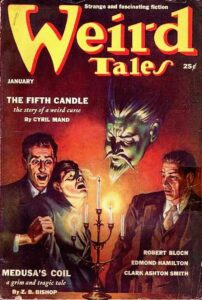
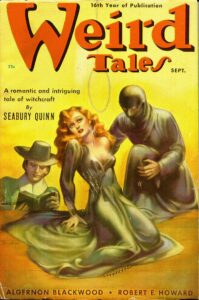
Want to See More?
If you love the pulps and would like to see more pulp horror magazine covers, check out our 2024 Vintage Pulp Horror Calendar, a terribly good collection of pulp horror cover art. Take a look here.

